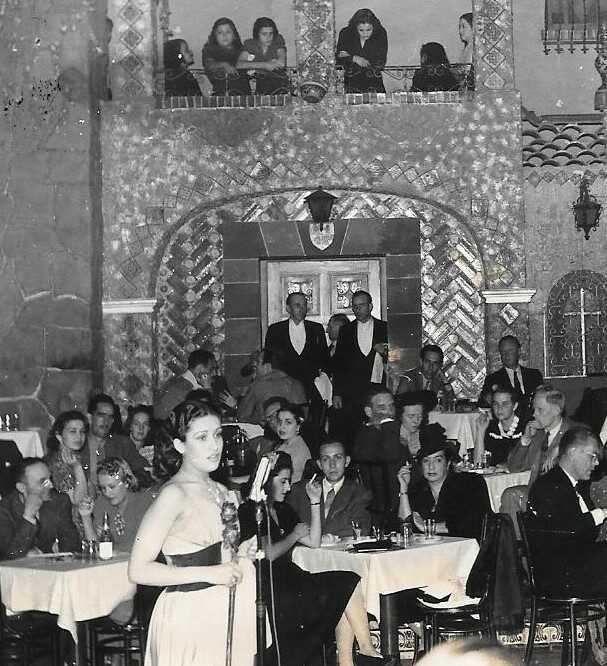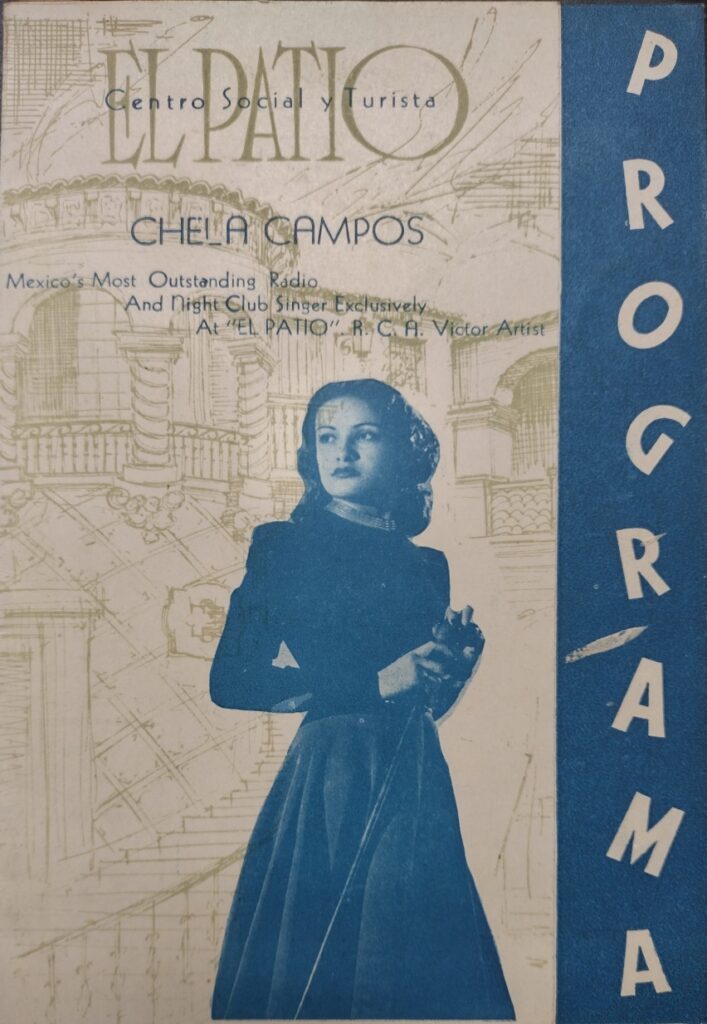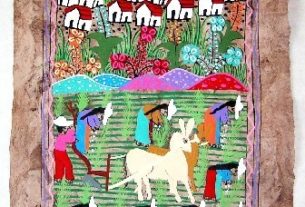D. A. Huse
Between working her daytime radio shows. Chela was also asked to sing in various theaters and nightclubs in the city. Construction began on the Palacio de Bellas Artes in October 1904, and its inauguration was in 1934. Located in the center of Mexico City near the Alameda Park, it quickly began hosting all forms of performing arts events, as well as literary and visual arts exhibitions. On September 12th, 1939, Chela Campos was asked to sing there at the 115th anniversary of the annexation of the State of Chiapas to Mexico, an event presided over by President Lázaro Cárdenas. Chela sang the song ‘Perfidia,’ written by Alberto Dominguez B., who accompanied her on the piano during the performance.

Chela performed at Bellas Artes again on February 2nd, 1942, singing ‘Mujer’ by Augustin Lara, played by the Juan S. Garrido Orchestra. This was to commemorate the 9th anniversary of the Railroad Operators’/Workers’ Union. Coincidentally, years later, her stepbrother, Flabio Campos Santana, also sang there as a tenor in several opera productions.
On December 25th, 1939, she performed at the Arena Monterrey Theater in Nuevo León. Also appearing that day were singing group Los Plateados, the dancers Pepe & Carola, Genaro Salinas, and Argentinian trio ‘Sherlock Holmes’ to name a few. She also performed in Mexico City at the Teatro Follies Bergere in February and May 1942, at shows which also featured Pedro Vargas, Trio Tariacuri, Hermanas Aguilar, Bob Brawley, Raúl Antonio Martínez and Spanish Flamenco dancer Conchita Martínez with her guitarist Pepe Badajoz. Cantinflas appeared as well doing a comedy sketch. These shows were somewhat like Vaudeville theater shows in the USA.
On March 5th, 1942, Chela appeared at the Teatro Lírico with a group of other entertainers, and the follow month she sang at the Teatro Bucareli, where they had radio artists singing before the movie started and during the intermission—artists like Mapy Cortés, Pedro Vargas, las Hermanas Aguilar and Fernando Fernández, the same man who got Chela her private audition at the XEW radio station.
Chela also performed at many other movie theaters, such as the Teatro Alameda and the Teatro Palacio Chino, throughout the 1940s, whenever she wasn’t traveling. She was a firm believer that she needed to perfect her performances, and that the only way to do this was by accepting every opportunity that arose.

In January 1941 she became a headliner at ‘El Patio,’ a famed elite nightclub-restaurant in Mexico City. Decorated to look like a Spanish hacienda, it had stuccoed walls decorated with flowers, tiled roofs over little balconies with tables, and more tables arranged around the dance floor and stage. It was the most popular nightclub in the city for American tourists.
As part of her contract she was required to sit with the patrons and make pleasant conversation. She confided in me that this was the only part of the job she didn’t like. The floor manager chose which tables she had to visit, and most of the time it was pleasant because they were couples for a night out. However, things could get a little uncomfortable when she was asked to visit with men. They often got too personal, wanting to know about her love life and asking her out on dates. She never dated any of the nightclub patrons, but did tell me about one boyfriend, who was a well known Venezuelan baseball player. When she learned that he was already married, she dropped him. She told me that she then became married to her career, which was a lot easier on her heart. Chela did not let anything get her down for long and had a very positive attitude about life; she never lost her love of performing.
She began recording records exclusively with RCA Victor as early as 1939; many of her records became the label’s best sellers month after month. One day, at a party at her friend’s house, Consuelo Velázquez, played her new song ‘Bésame Mucho.’ Although singer Emilio Tuero recorded it in 1941, Aunt Chela took the song to Cuba with her, where it became an important part of her repertoire.
She received many tributes in the entertainment newspapers: Claridades on August 25th, 1940, declared her as the best singer on the radio. By 1941 she was recognized as the number one star of Mexican radio. This was not only because she had a beautiful voice, but also because she was a genuinely warm and humble person. She always made her audience feel like they were the most important thing in her life. Stopping to give autographs was never a problem, and people mobbed her at the doors of XEW radio station.
The years went by and musical tastes changed. Chela used to say that Rock and Roll killed Bolero. I first saw her perform in 1973 at the Teatro Blanquita, with Lucho Navarro, María Luisa Landín and many others as part of the show. It was the first time I saw her perform and it was remarkable. The audience was really listening to her and she looked so happy. Her presence filled the huge stage; she drew us in with her smile and her beautiful voice. She spoke to us between songs giving the audience an introduction to what she was about to sing. She continued to sing regularly at many nightclubs and theaters into the early 1980s.
She tried to invest in different businesses in order to have a steady income. A friend of hers thought of opening a Mexican Restaurant in Los Angeles in the 1960s. When she asked her stepsister Carmela (my mother-in-law) to come along to do the cooking, she agreed. After completing all the requirements to get her a work visa and a student visa for her son (my husband), Carmela decided to stay in Mexico City and get married, and the restaurant investment fell through.
Chela tried to invest her savings in several other businesses in Mexico because, not having a husband, she felt she needed to do this to secure a future when she was no longer able to sing. However, she soon discovered that her siblings didn’t want to do all the work required to make them successful. After a few failed attempts, Chela declined further requests, knowing that she could not afford to waste away her savings. She sold her beautiful home in Polanco, dispensed with the chauffeur and maids, and bought a condo and an automatic car and became self-sufficient. She had a person come in to clean once a week, but did everything else herself. In the 1970s, Bolero songs became popular again, and Chela began to sing in the “Golden Age” television shows she was invited to. She also continued to receive some royalty money from her songs and records.
When I married her nephew in 1971, she would come over to our apartment twice a week: first, to take me to the market and teach me how to cook something, and again later that week for me to cook for her. She said it was because her nephew had to eat, but we both knew I couldn’t cook! We would have music playing and she would begin to sing along at the drop of a hat. One time, she put a record on and proceeded to show me how she could change her voice to sound just like Dionne Warwick—it was wonderful. Her voice filled the small apartment and it was so loud without any need for a microphone.
Twice a month she would take me to see the new movie releases at “Estudios Churubusco.” She would laugh as she warned me that we probably be watching a B movie, or ‘churro’ as she called them. Afterwards, she would always give her critique to the studio people that were in attendance. They always showed her the utmost respect, and it was really amazing to see her turn on the artist personality. Her friend Grace Navarro would stay with her a few months a year and they became as close as sisters. They forged their friendship when Aunt Grace’s good friend, Sergio Orta, a Cuban Entertainment Director for the Tropicana Cabaret, asked her to help a new young artist, Aunt Chela, while she was performing in Cuba. Grace had Chela stay at her mansion overlooking the water in Miramar, Cuba. Their nights were filled with song and dance, and they slept in late and woke up to Aunt Grace’s pet capuchin monkey jumping on her head!

When Chela died, her stepsisters went through everything in her house looking for her jewelry and money. Per Aunt Chela’s request, Aunt Grace moved the limited valuables to a safe place at a close friend’s house. The step-siblings then had Aunt Grace arrested, but, thanks to friends in high places, Grace was released without a problem and left the country. The step-siblings boxed up all of her possessions and raffled them off between themselves; they did nothing to preserve the memory of Chela Campos. Because Aunt Chela died without a will, there was nothing we could do to remedy this.
Years later, Aunt Grace came to live close to me. She told me wonderful stories about Aunt Chela. There are very few articles about her circulating on the internet, but I hope to remedy this and am currently working on a book about her, as I promised Aunt Grace I would do. Aunt Chela and Aunt Grace are both embedded in my heart forever.
- Part One: Our Aunt Chela: international singer Chela Campos, aka The Lady with the Crystal Cane
- Part Two: Our Aunt Chela: Chela Campos – Radio Days

